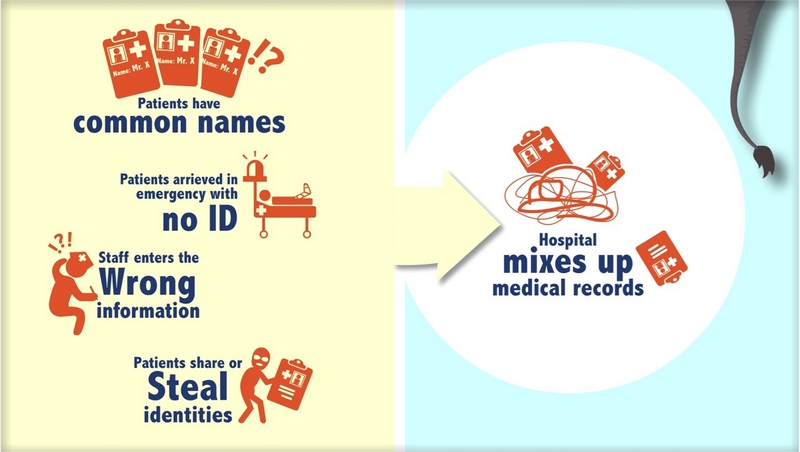Patient Identity Matching – Solving an unsolved crisis with RightPatient

Accurate patient identity matching holds paramount significance across the U.S. healthcare system. Delivering the best possible patient experience, including safety and outcome, hinges on the ability of the healthcare providers to keep and maintain accurate medical records. Healthcare providers continue to struggle to accurately match their patients’ identities to their health records, and blame it on inaccurate and incomplete patient data, says the Government Accountability Office (GAO). Physicians should be able to retrieve accurate records on each patient’s medical history, including lab results, diagnoses, medications, imaging, surgeries, etc. to deliver the best patient care. Needless to say, accurate patient identity matching during the COVID-19 crisis is vital for ensuring a positive patient experience.

Can healthcare providers solve the patient identity matching crisis? Yes, and the solution is RightPatient – a leading touchless biometric patient identity management platform that has been successfully helping many leading hospitals address this specific issue.
Accurate patient identity matching ensures that the right patient is associated with the right medical records within a healthcare system. It means knowing with certainty that a piece of medical information belongs to the correct individual. There are many consequences if records are mismatched, such as incorrect treatment, improper data entries which can lead to the creation of duplicate records, and medical identity theft. Effective patient identity matching is not just about patient safety, it also helps healthcare providers avoid financial losses associated with duplicate records and claim denials from medical identity theft.
How costly are patient identity matching errors?
Let us look at this example. A patient’s kidney was surgically removed by the time physicians realized that there was no tumor. This blunder in the operating room of Saint Vincent Hospital in Worcester, Mass., occurred when the patient’s CT scan was accidentally mixed up with the record of another patient who had the same name. The incident was widely reported in July 2016 when regulators came to investigate what exactly happened. Most people who read the accounts thought it was a rare blunder. But this type of blunder is not rare at all.
Every day in medical clinics and hospitals, physicians assume they have an accurate picture of a patient’s medical history, diagnoses, lab results, and other information when they click into an electronic medical record (EMR). But this assumption can lead to fatal consequences, like the example mentioned above.
The problem is called patient identity matching error, a crisis that RightPatient has been addressing for years. One of the most severe match errors is when two patients’ medical records, with a similar or same name, get merged, leading to an erroneous organ removal or other nightmares. More common than this is the creation of duplicate medical records. For instance, Christina Elizabeth Smith, Cristina E. Smith, and C. E. Smith refers to the same individual, but her medical information is filed under three separate records. Neither the physician nor the patient will be aware of missing data points when they are discussing treatment decisions or procedures.
The problem with common identifiers
Duplicate medical records can be created in many ways. One of the most common sources of duplicate records is making errors during the patient registration process. Other variations can be associated with identifying an unconscious patient when they are in the ER. Many times, duplicate records are also created due to demographic changes for the patient. Registrars face difficulties when patients change their last name or move to another place, so they create a new record for that individual.
Patient identity matching errors can also occur when there is a variation in using common identifiers during the registration or identification process. A simple typo or mishearing the correct word can result in a mismatch in records.
Common identifiers are also used to commit medical identity theft, an issue that healthcare providers have been trying to avoid for the past several years. A fraudster can easily get access to this type of information and fraudulently imitate someone else’s identity to get medication/benefits for their own use.
These kinds of problems can be mitigated if common identifiers such as names, DOB, SSNs, or other demographic data used during the initial registration and identification process are replaced with the unique identifiers that RightPatient uses. For instance, identifying and authenticating an individual by using their iris pattern or a photo of their face.
Accurate Patient Identity Matching with RightPatient
RightPatient is a touchless biometric patient identity management platform. Problems pertaining to duplicate records, medical identity theft, and record mismatch have been successfully mitigated by using RightPatient. Leading healthcare providers such as Terrebonne General Medical Center and The University Health Care System have successfully eliminated these sorts of problems and are continuously delivering the best experience for their patients with utmost clinical efficiency.

During the initial patient enrollment process, RightPatient will lock an individual’s medical records using their iris pattern or a photo of their face. Each time a patient arrives at the continuum of care, RightPatient will verify and authenticate their identity through an iris scanner, camera, or a webcam and retrieve their accurate medical records.
As a leader in the patient identity matching process, RightPatient helps healthcare providers to keep and maintain accurate medical records of their patients. Patient identity matching problems related to aggregating patient data via Health Information Exchanges (HIE) can be eliminated if all the healthcare providers adopt RightPatient, ensuring the best clinical outcome and data integrity across the healthcare system.
Due to the COVID-19 pandemic outbreak, touchless biometric technologies will play a key role in the next few years. RightPatient ensures safety and hygiene in a health facility by limiting physical contact between people and frequently touched high-risk surfaces, such as fingerprint scanners. Adopt RightPatient and make sure that one patient does not have multiple records in the master patient index (MPI) and that each piece of health information ends up in the correct patient record.









Leave a Reply
Want to join the discussion?Feel free to contribute!